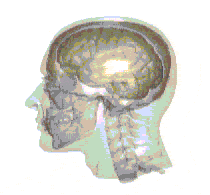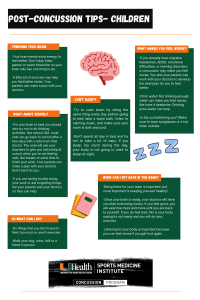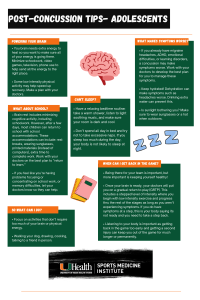Concussion FAQ

Red areas show where the brain impacts the skull due to the shift in momentum.
A concussion is a medical diagnosis that is induced by biomechanical forces, such as a bump, blow, or jolt to the body, with an impulsive force transmitted to the head.
Our brain is surrounded by a layer of cerebrospinal fluid that generally prevents it from shifting in your skull. However, when a sudden force is applied to your head or your body, the weight and momentum of your brain can cause it to temporarily displace the cerebrospinal fluid, causing the brain to impact the inside of your skull. This impact causes the concussion injury. Medical professionals also refer to concussions as a "mild traumatic brain injury," or "mTBI."
Most importantly, a concussion injury can temporarily alter the way your brain functions, and may cause mood swings, headaches, lapses in memory, judgement, concentration, balance, and coordination. Concussions can occur with or without a loss of consciousness, and symptoms may last for a few weeks or months.
Like any other injury, a concussion needs time and rest to heal.
Warning: Undefined variable $silent in /home/kidzezvb/public_html/concussion/wp-content/plugins/footnotes-for-wordpress/wp-footnotes.php on line 156
I thought concussions are life-threatening.
Science is still learning about the long-term effects, but concussions are usually not life threatening if treated properly.
Concussions become dangerous when they are not treated, and when compounded by multiple concussions. Recent research has connected the deaths of many pro football players and other athletes that have been found to have chronic traumatic encephalopathy (CTE) at autopsy, a disease that causes degeneration of the brain. Though science is still learning about CTE, this disease is most likely caused by multiple, repeated concussions; a problem that is preventable through the application of proper sports concussion protocols and management.

Left) A normal brain of a 65 year old
Center) The brain of former NFL linebacker who suffered 8 concussions and died at age 45
Right) The brain of a 73 year old boxer who suffered from an extreme form of dementia pugilistica
(Photo credit: WBUR Boston)
Second impact syndrome (SIS) is another life-threatening condition relating to concussions, though extremely rare. SIS is caused when a concussed brain receives a second concussion before the first has healed (healing can range anywhere from minutes to weeks after the first concussion), causing a rapid swelling of the brain. This limits blood flow and can cause cerebral edema and brain herniation.[1]
For the average person and youth athlete, neither CTE or SIS is a concern when proper safety measures are taken. The injured person must rest and recover as prescribed by a physician trained in the management of concussions.
What should I do if I think I have a concussion?
The first and most important thing is to STOP. Sit down, and tell a parent immediately; if playing youth sports, notify your coach or athletic trainer. If you can't seem to think, ask a teammate to convey that you must be taken out of the game.
Once out of play, immediately seek medical attention from a physician with experience in concussion management.
Common signs of a concussion:
- Trouble recalling facts surrounding incident
- Appears dazed
- Repeated vomiting
- Abnormal fatigue
- Confusion
- Irritability
- Difficulty remembering
- Difficulty paying attention
- Slow reaction time
- Mood, behavior, or personality changes
Will a concussion cause loss of consciousness?
Not directly. A concussion usually involves an alteration of consciousness, but it does not always result in a loss of consciousness. However if a prolonged loss of consciousness does occur, it is very important that the injured person be taken to a medical professional as soon as possible. Likewise, youth athletes must be taken out of play immediately, regardless of their conscious state.
How do I recover from a concussion?
You must give your brain time to heal by following a recovery protocol to mentally and physically rest. Do not exert yourself or play sports, especially contact sports. Rest your mind and avoid texting, video games, computer use, and watching television for the first few days after injury. Screens can affect your recovery.
Depending on the severity of your concussion, your doctor might write students academic accommodations. Academic accommodations request that your school/teacher provide a reduced work load, extra time for exams, and deadline extensions to compensate for the alteration in brain processing from your injury.
Once you are asymptomatic (which means all of your symptoms have disappeared) your doctor will advise you to begin the "gradual return to play" process. However, if any symptoms re-appear, stop playing, consult your athletic trainer and physician, and restart the recovery protocol.
I am a youth athlete. How long must I stay out of play?
You should stay out of play as long as your doctor tells you to. This should be at least one week in order to complete the gradual return to play checklist without any symptoms, though severe concussions (particularly those caused by playing through a game with a concussion) can last for weeks or months depending on the severity. Every concussive event is different, even for the same person.
Where should I go to get checked up and cleared?
Immediately following the injury - depending on severity - a trip to the emergency room can rule out any life-threatening injuries.
Afterwards, you should see a physician trained in the management of athletic concussions for a checkup, and follow concussion recovery protocols until asymptomatic. Once asymptomatic, the athlete should follow up with a physician with experience in concussion management in order to get cleared for gradual return to play.
Warning: Undefined variable $silent in /home/kidzezvb/public_html/concussion/wp-content/plugins/footnotes-for-wordpress/wp-footnotes.php on line 156
An estimated 1.6 to 3.8 million[2] sports-related concussions occur each year. Recent research suggests that this number is significantly higher due to underreporting of injuries, though recent reporting has increased exponentially.
Warning: Undefined variable $silent in /home/kidzezvb/public_html/concussion/wp-content/plugins/footnotes-for-wordpress/wp-footnotes.php on line 156
Does concussion risk vary by gender?
Research published in the Journal of Athletic Training found that females are twice as much at risk for concussions because of underdeveloped neck musculature. For high school sports, football has the most concussions reported at 40.5%, followed by girls' soccer (21.5%) and boys' soccer (15.4%)[3].
Warning: Undefined variable $silent in /home/kidzezvb/public_html/concussion/wp-content/plugins/footnotes-for-wordpress/wp-footnotes.php on line 156
Warning: Undefined variable $silent in /home/kidzezvb/public_html/concussion/wp-content/plugins/footnotes-for-wordpress/wp-footnotes.php on line 156
Are there laws governing concussions?
As of January 30th, 2014, all 50 states and Washington, DC have passed youth sports concussion related legislation, known as "Return to Play" laws. Florida’s legislation requires immediate removal from practice or competition for a suspected concussion and written medical clearance to return to playing sports.[4][5]
Your treatment plan must also comply with the legislation in your state and the requirements of your respective organization. Most organized sports governing bodies also have their own concussion policies and regulations. These organizations include state high school athletic associations, clubs, leagues, and park organizations.
References
- [1]https://www.ncbi.nlm.nih.gov/pmc/articles/PMC2672291/↩
- [2]CDC, 2007: https://www.cdc.gov/media/pressrel/2007/r070607.htm↩
- [3]UConcussion - The Challenges of Providing Concussion Education to High School Football Players↩
- [4]2016 Florida Statutes 1006.20 (2)(l) - Athletics in public K-12 schools↩
- [5]2016 Florida Statutes 943.0438 2.(g) - Athletic coaches for independent sanctioning authorities.↩


